We have seen smaller Live distros than Slax (SliTaz, for instance), but Slax is by far the most famous and proven Live distro. Slax, though not at all officially related to Slackware, rigorously follows the Slackware release cycle. The subject of our review, version 6.0.9, was released on the same day as Slackware 12.2 (December 10, 2008). Built from Slackware 12.2, it has the same rock solid stability and simplicity, while maintaining the ease of use not found in its upstream versions.
Slax 5 to 6
Those who are still using Slax version 5 will find a lot of differences between Slax 5 and 6. These are:
- Most importantly, version 6 is available in only one edition. Slax 5 had Standard, KillBill (Microsoft Killer), Foro, Popcorn and Server editions. Slax 6 has none of the KillBill or Server features; they need additional modules to be downloaded.
- This brings us to modules. Previously, the Slax base was not a module, while anything running on top of it, was (such as X11). Now, everything is a module, even the base. Slax 6 comes with 6 modules—core, xorg, kde, kdeapps, devel and koffice. You can remove or replace these base components if you wish.
- X starts automatically! There’s no need to run
xconfandstartx. The downside of this is that you run in X as the root. - The Slax bootsplash flower has been done away with—there’s only boring text now.
Go Slax, go!
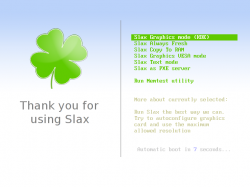
I downloaded Slax 6.0.9 and made it boot up on a VMWare Workstation VM. It, as always, didn’t fail to surprise me with its sub-10 second boot to KDE. But the boot threw up another surprise—a new option to start Slax as a PXE server. It turned out that this option makes Slax boot up as usual, but starts a TFTP server in the background with the Slax CD as the root. This means that if you were to start up a computer and boot from a network, Slax would boot as if the CD was inserted locally in the client’s PC. Neat!
I still detest what they did to the bootsplash. Slax 5 used to have a Slax flower above the scrolling boot log, but it has been done away with in version 6. I wonder why.
Slax’s ‘Always Fresh’ feature is another neat trick. Suppose you had been saving a persistent home all along, but suddenly wanted to boot a pristine distribution, the ‘Always Fresh’ option will ignore the persistence file.
You don’t need to download the tarball and ISO separately for the USB and CD; each will work for the other. If you downloaded the ISO, burn it to a CD or DVD and it will work fine. If you want a USB version, copy everything inside the ISO to the root of the USB drive and run /media/disk1/boot/bootinst.sh (assuming /media/disk1/ is the directory where your USB stick is mounted) to make the USB stick bootable. Conversely, for the tarball, the USB installation procedure is the same, but if you need an ISO, run the script slax/make_iso.sh to create an ISO and burn it to a CD or DVD.
The GUI—Slacks and boots
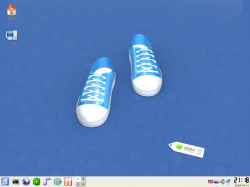
Less than 10 seconds after I hit ENTER on the SYSLINUX boot menu, I was greeted by the KDE 3.5.10 splash screen and the Boots wallpaper. Nothing has really changed here; it’s all the same as in the earlier version 6 desktops. One word of advice: the root password is ‘toor’, if you ever need it.
X defaulted to 800 x 600 in VMWare. It doesn’t include ATI or NVIDIA drivers, and due to a lack of blanks, I was unable to test out native on my NVidia 7100 iGPU. If it doesn’t work, you should be dropped to a console. Type in guisafe and X should start up in VESA mode.
The following table sums up all the software included with this version. Slackware 12.2 came as a disappointment to me—no KDE4, no Python 2.6 and no GCC 4.3, while Slax seems to have taken all the software that Slackware had. The latest KDE 3.5 stable release is included, and all the apps are Qt-based (with no space for GTK+).
| Category | Software included |
| Games | KBattleship, KBounce, Patience |
| Graphics | KuickShow (image viewer), KolourPaint (Paint-like software), KSnapshot (screenshot capture), KKolourChooser (colour chooser) |
| Internet | Konqueror, KMail, Kopete, Akregator, Krdc (remote desktop), Krfb (VNC), KNetAttach (network folder browser), KPPP, network-conf, KWiFiManager |
| Multimedia | JuK, KPlayer, KsCD, K3B, KAudioCreator, KMix |
| Office | KWord, KSpread, KPresenter, Kontact, KPDF |
| Utilities | KJots, KWrite, KNotes, Klipper, KCalc, Ark |
| System | Slax Module Manager, KInfoCenter, KSysGuard |
| Command Line | GCC 4.2.4, BusyBox 1.11.1 |
The absence of Mozilla Firefox really infuriated me; Konqueror 3 is not at all a replacement for Firefox, but it still works. When it comes to the Web, I was unable to configure my ADSL (broadband) service in a bridge mode whatever I did. Looks like I have to keep my modem in PPPoE mode. RP-PPPoE is included, but it didn’t work. Two more things to whine about—no torrent client and no firewall.
As with Slax, MP3s play out of the box. WMAs don’t, but that’s the same as with JuK. The media player KPlayer uses MPlayer as its backend and can play anything that is thrown at it.
Under the hood
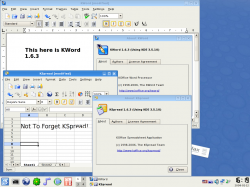
Under the hood, Slax runs on Linux 2.6.27.8, which is not the stock Slackware kernel. Since the kernel had to be re-built (patched to support LZMA and AUFS), I guess Tomáš Matějíček (the Slax developer) went with the latest kernel. All the command-line utilities are provided by BusyBox 1.11.1 (what a version!). SquashFS has been upgraded to version 3.4 and fixes a bug with the earlier UNSQUASHFS version. Slax 6 uses AuFS (Another Union File System) to stack each of the SquashFS modules. It boots using the initrd, which has the AuFS drivers, then inserts each module from the base directory. When it’s done, all modules from the modules directory are inserted. Finally, KDE is started!
What else?
Customised versions of Slax don’t have to be built manually. You can get a custom build from the website. Go to www.slax.com/build.php. Add or remove any modules you may want. As of now, you can choose between 1,284 modules. When you are done, use the links to download a TAR or ISO. There are some limitations, such as non-resumable downloads, lack of personalisation options, etc, but for now, a rudimentary set-up like this works okay.
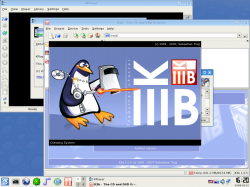
Derivatives
Slax is a very modular and layman-customisable distro. Thus it is no surprise that derivatives start springing up all over the place. Linvo deserves a special mention. It is a GNOME-based Slax-derived distro that is by all means complete. It includes Wine, Firefox and Code::Blocks for development (they just hit my soft corner with Code::Blocks). Linvo can be used as a minimalist home distro that includes one app for every task you need to perform.
The bottom line
Slax 6.0.9 is as always a heck of a distribution. It’s by no means a distro you would use for recovery purposes; for that, SystemRescueCd is the one and only choice—but as a minimalist distribution, it is very complete. One possible use is that you could create a Persistent LiveUSB with Slax and carry it around with all your files. This way you have an entire computer in your pocket, which just needs a… well, computer, to run. For basic recovery purposes (such as an OS crash or back-up restore) Slax can work, and you can use it as the main OS in lower spec’d or prehistoric computers (it just needs 128 MB of RAM to work). It’s very uncomplicated, and can be used by beginners or teachers to teach Linux (from an end-user viewpoint). Overall, it is a worthy upgrade to any Slax fan, Slackware fan, Linux lover, Linux hater… well, just about everybody.
Postscript: Linux live scripts
Slax is built from a stock Slackware installation and a customised kernel. And the good news is, the entire build system is available for you to use and is distro-independent. So if you want to build Ubuntu-Slax, Debian-Slax or Fedora-Slax, or just about any Slax, start by installing LZMA, AuFS and SquashFS. Then get the kernel source and patch it to support all of these. Finally, go to www.linux-live.org and download the live scripts. Execute them to get your own Slax ISO. All instructions are available in detail at the Linux-live website. Remember, by this method, anything in your system’s filesystem is included in the Live distro.

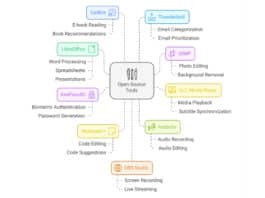


Can someone tell me where I can get that sneaker/boot wallpaper??? I’ve really wanted it from the first time I used Slax.